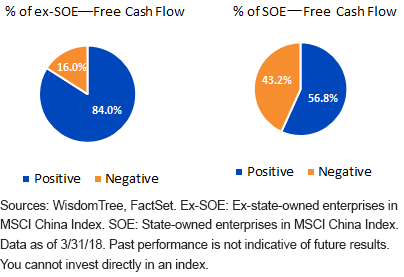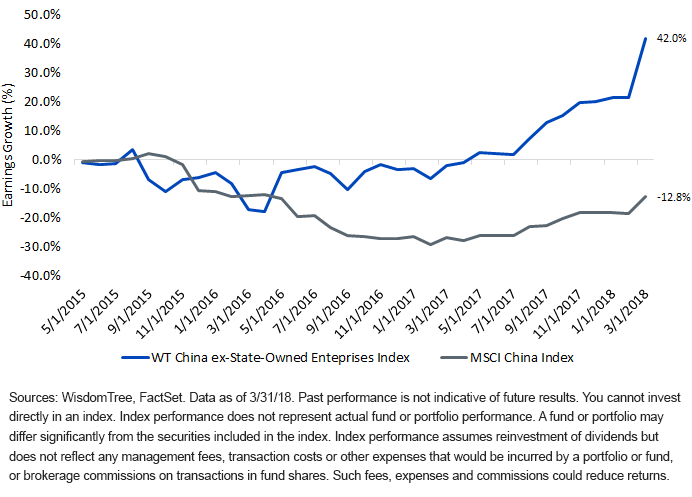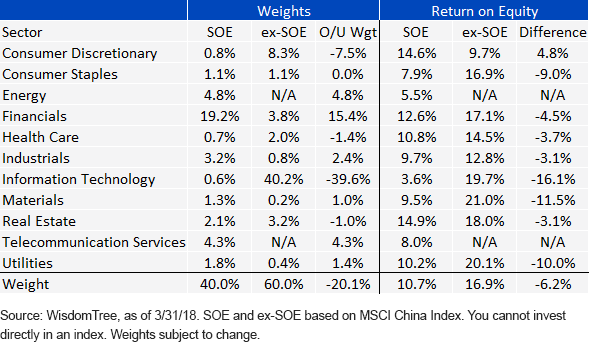Evaluating Recent Fundamental Trends in Chinese Ex-State-Owned Enterprises



Investing in China has long been complicated by concerns over the country’s so-called “state capitalism.” In its broadest definition, state capitalism refers to combining the elements of a powerful state with a capitalist system to promote strong and steady economic growth. Judged by the criterion of strong and steady economic growth, many would argue that China’s Politburo deserves high marks. From a long-term investor’s perspective, the report card is a bit murkier.
Grading SOEs: Negative Free Cash Flows and Lower Returns
The government’s entrenchment in the private sector through state-owned enterprises1 has forced investors into the reality that investing in China must therefore mean investing alongside the Chinese government. In many instances, shareholder return may not necessarily be the top priority. The result: an overindebted system and lackluster returns compared to private market peers. As we show below, this has resulted in a material impact on these businesses’ ability to generate positive free cash flow.
SOE vs. ex-SOE: Percentage of Companies with Negative Cash Flows

Similarly, the returns of the state-owned segment over the last decade have dramatically underperformed the ex-state-owned segment. Despite making up only a quarter of the Index weight over the last decade, on average, the ex-state-owned segment generated more than 80% of the contribution to returns to the Index. That is because non-state-owned companies outperformed state-owned companies by more than 1,000 basis points (bps).
MSCI China Returns: Ex-State Owned Outperforms State Owned

Earnings Growth Disparity
In addition to the performance disparities, there clearly also has been a dramatic differential in the primary driver of those returns: earnings growth versus multiple expansion. Cumulative earnings growth for the MSCI China Index, which was more than 70% state-owned companies historically, has been negative over the last three to four years, while the WisdomTree China ex-State-Owned Enterprises Index was quite positive and has accelerated up in recent quarters. This earnings differential is not surprising when one considers that the Chinese government does not invest in companies for a return on their investment the same way private investors do. In fact, the Chinese government often invests in unprofitable companies exactly because they are unprofitable, and the government takes a stake to stabilize them. On the macro level, this aligns with the government’s policy of allowing for a “slow landing” and moderating the economic cycle, but from an investor’s standpoint, investing alongside the government has not been historically profitable.
Cumulative Earnings Growth Since Inception

State-owned companies can tap cheap financing from state-owned banks, creating a system of risk concentration within state-owned enterprises that imposes a degree of fragility on the Chinese economy at large. Reforms over the past several years have resulted in significant strides by these companies, largely state-owned enterprises, to reduce this leverage.2 Such reform is creating great opportunity for investors in China broadly by reducing its systematic risk. We have optimism in the long-term reform of the state-owned enterprises, but the reality of the present system leads us to advise investors to consider an approach to ex-state-owned enterprise investing in China that can be used to complement or replace a broad China exposure. A summary of our case is threefold:
- Sectoral Shifts: State-owned-enterprises are concentrated in the Energy, Financials and Telecommunications sectors, as opposed to the fastest-growing and most innovative Information Technology and Consumer Discretionary companies, like Tencent, Alibaba and JD.com.3
- Profitability and Valuations: State-owned enterprises have not rewarded shareholders to the same degree as non-state-owned enterprises over the past 10 years as measured by profitability metrics such as return on equity (ROE). Despite their growth and profitability, ex-state-owned enterprises are at similar valuations to their more mature and less profitable state-owned peers. The table below of ROE by sector reveals the significant return differentials across sectors between SOEs and non-SOEs, the largest of which is from the Information Technology sector (-16%).
- Negative Free Cash Flows: Reform and deleveraging are under way, but the risks of negative free cash flows and a misalignment of shareholder and government interests persists as another risk that may or may not provide investors with a commensurate return premium.
Return on Equity and Sector Weights for SOEs and ex-SOEs

Conclusion
In our view, investors should continue to reassess the implicit bets they’re making when broadly investing in emerging market countries such as China. While investing alongside the government can limit downside risk in adverse market scenarios, we continue to believe that government ownership on net serves as a greater hindrance than benefit to firm profitability over market cycles. For investors who seek to limit exposure to state capitalism in China, the WisdomTree China ex-State-Owned Enterprises Fund (CXSE) provides exposure to Chinese firms with less than 20% government ownership. For a deeper look, click here for our full white paper on the WisdomTree China ex-State-Owned Enterprises Index.
1State-owned enterprises: State-owned enterprises are defined as government ownership greater than 20% of outstanding shares of companies.
2Source: Edward White, “China SOE leverage to decline further in 2018: Moody’s,” FT.com, 1/7/18.
3Click for current holdings of the WisdomTree China ex-State-Owned Enterprises Index and the WisdomTree China ex-State-Owned Enterprises Fund.
Important Risks Related to this Article
There are risks associated with investing, including possible loss of principal. Foreign investing involves special risks, such as risk of loss from currency fluctuation or political or economic uncertainty. The Fund focuses its investments in China, thereby increasing the impact of events and developments associated with the region, which can adversely affect performance. Investments in emerging or offshore markets are generally less liquid and less efficient than investments in developed markets and are subject to additional risks, such as risks of adverse governmental regulation and intervention or political developments. The Fund’s exposure to certain sectors may increases its vulnerability to any single economic or regulatory development related to such sectors. As this Fund can have a high concentration in some issuers, the Fund can be adversely impacted by changes affecting those issuers. Please read the Fund’s prospectus for specific details regarding the Fund’s risk profile.
The Global Industry Classification Standard (“GICS”) was developed by and is the exclusive property and a service mark of MSCI Inc. (“MSCI”) and Standard & Poor’s (“S&P”), a division of The McGraw-Hill Companies, Inc., and is licensed for use by WisdomTree Investments, Inc. Neither MSCI, S&P nor any other party involved in making or compiling the GICS or any GICS classifications makes any express or implied warranties or representations with respect to such standard or classification (or the results to be obtained by the use thereof), and all such parties hereby expressly disclaim all warranties of originality, accuracy, completeness, merchantability and fitness for a particular purpose with respect to any such standard or classification. Without limiting any of the foregoing, in no event shall MSCI, S&P, any of their affiliates or any third party involved in making or compiling the GICS or any GICS classifications have any liability for any direct, indirect, special, punitive, consequential or any other damages (including lost profits), even if notified of the possibility of such damages.



